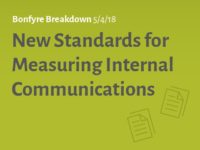Fear and company culture go together as well as drinking orange juice right after you’ve brushed your teeth: terribly.
There are several styles of fear-based leadership, and several reasons why fear in the workplace spreads so easily–none of them good. One of the most salient ideas around this is that fear stems from a lack of definition, alignment, and implementation of company core values. If you were to assess the core values of a random sample of 100 organizations, it is highly improbable you would ever see fear, manipulation and undermining on any of their value statements. And yet, these concepts and actions are prioritized and practiced at organizations across the country.
A leader’s actions are more potent than any written documentation of values. If a high-ranking leader practices severe command-and-control leadership technique, it will almost always supercede the lip service the company has paid to values like trust and integrity. In one of the most tangible expressions of Senn Delaney’s concept of “Shadow of a Leader,” those command-and-control, micromanaging, my-way-or-the-highway executives ultimately wind up modeling behaviors that define the organization’s terms of success. Leaders all the way down the chain of command, too, will begin to wield fear as management tool, because the people up top demonstrated it’s the only way to survive.
Fear-based company cultures become self-sustaining ecosystems. Leaders adept at wielding fear in the workplace will hire, promote and otherwise develop talent that can do the same. It’s not uncommon for organizations to selectively foster traits they believe are strategically viable. But research shows us that fear is not such a trait. While a certain degree of anxiety can be healthy, motivating individuals to overcome obstacles and reach greater potential, when fear is used manipulatively, employees burnout and disengage.
Several studies link stress and high-pressure environments to results nobody wants. Towers Watson found that 51% of employees who experienced high stress were disengaged in their work. Another study found that employees with high stress have 46% higher medical costs than those with low stress. Yet another study found, unsurprisingly, that job insecurity reduced employees’ job satisfaction and led to “deviant behavior” like employees putting less effort into their work, working slowly and taking longer breaks. At some point, the short term results fear in the workplace motivates simply do not outweigh its long-term costs.
HR’s capacity for change in a fear-based culture
When fear is ingrained deeply in company culture, it feels to the employees on the inside like it’s impossible to uproot. This is one area where human resources is uniquely positioned to break through the barrier. Whereas specific departments can all cite the ways fear influences the things that fall under their purview, HR’s purview is the entire company. More than any other department, HR has the resources, and more importantly the responsibility, to have hard but necessary conversations with leadership about the issue at hand.
Related: How Getting Real With Leaders Can Help Company Culture Change
Any time a company has a crisis of ethics or integrity, people look to HR. After all, one of the department’s core functions is to manage risk and liability to the company. Make no mistake, fear-based leadership is a liability. When fear goes unchecked in a company, it reinforces toxic behaviors that can escalate to scandalous proportions. Just last year, we saw two prominent, worst-case scenarios of fearful cultures gone awry in Uber and Wells Fargo. By addressing the issue with leaders head-on, HR business partners can improve the welfare of employees and avoid becoming the next big headline in the process.
And it’s worth noting that while the notions of culture ownership are evolving, HR on the whole is very much its steward. Culture is another area where any time fear draws the gaze of the public eye, the first thing out of people’s mouths is, “Well, what was HR doing?” And if you’re in HR and doing your job right, you should be paying attention to the outcomes fear is producing. What is happening to turnover as a result of this high-pressure scenario? What about productivity? Engagement? HR professionals already know these metrics don’t exist in a vacuum. Trends arise as a direct result of the pattern of behaviors occurring within the company. It would be irresponsible to translate these numbers for leaders only when they look good for business.
What HR should know before speaking up about fear in the workplace
Speaking up is worth it because it erases the notion of plausible deniability. Whereas some leaders may be ignorant of their actions, HR is the one department that can put a stake in the ground and make them aware of what fear is doing to the company. But be forewarned, if you’re considering giving this feedback to leaders, you’ll need to build your case ahead of time.
This meeting is not the time to “wing-it.” If you’re making the case for organizational change, you have to enter the room with your facts memorized. Bring all the data you have on things like employee engagement, job satisfaction, productivity, turnover, and more. But don’t stop there. You need to connect that data to feedback from employees to establish the the link between the leadership behaviors and culture. Although employees are often wary to give feedback when there’s fear in the workplace, I’ve found feedback from exit interviews are honest and compelling, and certainly worth discussing with leaders.
You’ll also want to set expectations early. Tough feedback is, charitably speaking, unpleasant to give. Leaders need to be prepared ahead of time that your conversation will be not be easy, and that you’ll need the time to say what you need to say uninterrupted. Once you’re in the flow of things, pay attention to how they respond, too. Though fear in the workplace may be pervasive, even leaders can be taken by surprise when they learn the ripple effects of their behaviors.
The real litmus test here is what leaders do with the information they’ve been given. Every person has the capacity for change, and a good leader will respond to hard feedback with appreciation. These leaders understand the value of criticism, even if they don’t agree with it, and will consider next steps. Bad leaders will be combative. They’ll want to debate and justify their actions as “right” or the “only way.” And in that scenario, you might find it’s time to consider looking for work elsewhere.
Personal levels of integrity are just that, personal. When there’s fear in the workplace, everyone will develop their own understanding of what it means to act with integrity and what you need to do to survive. I’ve found that having those tough, but necessary conversations makes me a better HR business partner. But if you’re an HR practitioner who remains on the fence about speaking up, remember this: indecision is still a decision within itself.
This article was originally published on TLNT under the title “What Can HR Do About A Fear-Based Culture.”



 5 min
5 min




